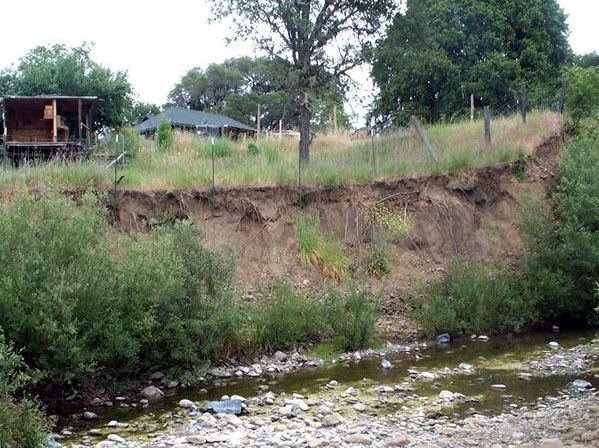 | ||
Stream restoration or river restoration, sometimes called river reclamation in the UK, describes a set of activities that help improve the environmental health of a river or stream. These activities aim to restore the natural state and functioning of the river system in support of biodiversity, recreation, flood management and landscape development.
Contents
- Restoration techniques
- Channel modification
- Cross vanes and related structures
- Imbricated rip rap
- Step pools
- Brush layering
- Engineered log jams
- Off line techniques
- Monitoring of restoration projects
- References
Improved health may be indicated by expanded habitat for diverse species (e.g. fish, aquatic insects, other wildlife) and reduced stream bank erosion. Enhancements may also include improved water quality (i.e. reduction of pollutant levels and increase of dissolved oxygen levels) and achieving a self-sustaining, functional flow regime in the stream system that does not require periodic human intervention, such as dredging or construction of flood control structures. Stream restoration projects can also yield increased property values in adjacent areas.
Stream restoration differs from:
Restoration techniques
Restoration activities may range from a simple removal of a disturbance which inhibits natural stream function (e.g. repairing or replacing a culvert, or removing barriers to fish such as weirs), to stabilization of stream banks, to more active intervention such as installation of stormwater management facilities, such as riparian zone restoration and constructed wetlands. The use of recycled water to augment streamflows that have been depleted as a result of human activities can also be considered a form of stream restoration
Successful restoration projects begin with careful study of the stream system, including the historical weather patterns, stream hydraulics, sediment transport patterns and related conditions. Researchers evaluating restoration projects have found that many of these projects subsequently fail (e.g., with flooding or excessive erosion) because the projects were not designed with a sufficient scientific basis; restoration techniques may have been selected for aesthetic reasons.
Channel modification
Modifications to a stream channel may be appropriate to address degradation. Channel modifications may yield improved habitat for wildlife and plants in a stream corridor, but can result in flooding, excessive erosion or other damage if not carefully planned. Design of modifications involves a careful analysis of a complex fluvial processes. Alterations may include channel shape (in terms of sinuosity and meander characteristics), cross-section and channel profile (slope along the channel bed). Alterations affect the dissipation of energy through the channel, which affects stream velocity and turbulence, sediment volume and size distribution, scour, and water surface elevations, among other characteristics.
Cross-vanes and related structures
A cross-vane is a "U"-shaped structure of boulders or logs, built across the channel to reduce velocity and energy near the stream banks. It reduces bank erosion, maintains channel capacity and provides other benefits such as improved habitat for aquatic species. Similar structures used to dissipate stream energy include the W-Weir and J-Hook Vane.
Imbricated rip rap
Stones are placed along the stream bank in an overlapping pattern, to protect the bank from erosion or washout. This technique may be employed where the stream segment is highly confined, or where infrastructure is threatened.
Step pools
In downstream areas, rocks are used to build a series of pools that gradually lower the elevation of the stream and reduce stream flow.
Brush layering
Live branch cuttings are placed along the stream bank. As new plants sprout from the live branches, the roots anchor the soil and prevent erosion.
Engineered log jams
An emerging stream restoration technique is the installation of engineered log jams. Reintroduction of large woody debris into a stream is a fairly recent method that is being experimented with in streams such as Lagunitas Creek in Marin County, California and Thornton Creek, in Seattle, Washington. Because of channelization and removal of woody debris, many streams now lack the hydraulic complexity that is necessary to maintain bank stabilization and a healthy plant/animal habitat. Engineered log jams are individually designed to meet the needs of specific restoration projects, but there are overarching design elements. One element is to anchor logs along the stream bank in order to create a physical blockade against erosion. Large wood pieces, both living and dead, play an important role in the long-term stability of engineered log jams. A second element of engineered log jams is to improve fish habitat. Log jams add diversity to the water flow by creating riffles, pools, and temperature variations. This is vital to fish because it provides the right circumstances to spawn, rest, feed, hunt, and hide.
There are inherent dangers to engineered log dams. If not properly implemented, they cause erosion and sediment in unwanted areas leading to more damage than repair. Furthermore, the individual pieces of wood in logjams are rarely stable over long time periods and are naturally transported downstream where they are trapped by further logjams, if logjams are near to urban areas this can lead to wood being trapped against bridge piers or blocking culverts.
Off-line techniques
As part of a stream restoration project, stormwater management facilities may be installed in the immediate corridor or in upland areas. These facilities, which reduce the velocity and/or the volume of stormwater entering the stream channel, can also improve water quality, and include:
Monitoring of restoration projects
Sponsors of restoration projects may conduct monitoring of stream conditions after construction, to evaluate effectiveness. In some projects it may take considerable time before there is evidence of desired biological activity, such as fish spawning. Therefore, monitoring efforts may be conducted for several years after a restoration project has completed. "Practical River Restoration Appraisal Guidance for Monitoring Options" is a guidance document that aims to assist all practitioners in the process of setting monitoring protocols as part of a river restoration project.
